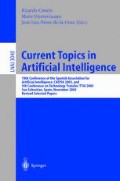Abstract
This paper discusses the analysis of differential pressure signals in a blast furnace stack, by a hybrid approach based on temporal representation of process trends and classification techniques. The objective is to determine whether these can be used to predict unstable conditions (slips). First, episode analysis is performed on each individual trend. Next, using the obtained episodes and variable magnitudes, the classification tool is trained to predict and detect the fault in a blast furnace. The proposed approach has been selected in this application, due to the best results obtained using the qualitative representations of process variables instead of only raw data.
Access this chapter
Tax calculation will be finalised at checkout
Purchases are for personal use only
Preview
Unable to display preview. Download preview PDF.
References
Aguado, J.C.: A Mixed Qualitative-Quantitative Self-Learning Classification Technique Applied to Situation Assessment in Industrial Process Control. PhD. Thesis Universitat Politècnica de Catalunya (1998)
Aguilar, J., López, N.: The process of classification and learning the meaning of linguistic descriptors of concepts. In: Approximate Reasoning in Decision Analysis, pp. 165–175. North Holland, Amsterdam (1982)
Cheung, J.T., Stephanopoulos, G.: Representation of Process Trends, parts I and II. Computers. Chemical Engineering 14, 495–540 (1990)
Dash, S., Rengaswamy, R., Venkatasubramanian, V.: A Novel Interval-Halving Algorithm for Process Trend Identification. In: 4th IFAC Workshop on On-Line Fault Detection & Supervision in the CPI, Seoul, Korea (2001)
Janusz, M., Venkatasubramanian, V.: Automatic generation of qualitative description of process trends for fault detection and diagnosis. Engineering Applications of Artificial Intelligence 4, 329–339 (1991)
Meléndez, J., Colomer, J.: Episodes representation for supervision. Application to diagnosis of a level control system. In: Workshop on Principles of Diagnosis DX 2001, Sansicario, Italy (2001)
Moore, K.: Using neural nets to analyze qualitative data. A Marketing Research 7(1), 35–39 (1995)
Waissman, J.: Construction d’un modele comportemental pour la supervisión de procedes: Aplication a une station de traitement des eaux Doctoral thesis - Institut National Politechnique de Tolouse, pp. 17–28 (2000)
Wong, J.C., McDonald, K.A., Palazoglu, A.: Classification of abnormal operation using multiple process variable trends. Journal of process control 11, 409–418 (2001)
Author information
Authors and Affiliations
Editor information
Editors and Affiliations
Rights and permissions
Copyright information
© 2004 Springer-Verlag Berlin Heidelberg
About this paper
Cite this paper
Mora, J., Colomer, J., Meléndez, J., Gamero, F., Warren, P. (2004). Hybrid Approach Based on Temporal Representation and Classification Techniques Used to Determine Unstable Conditions in a Blast Furnace. In: Conejo, R., Urretavizcaya, M., Pérez-de-la-Cruz, JL. (eds) Current Topics in Artificial Intelligence. TTIA 2003. Lecture Notes in Computer Science(), vol 3040. Springer, Berlin, Heidelberg. https://doi.org/10.1007/978-3-540-25945-9_40
Download citation
DOI: https://doi.org/10.1007/978-3-540-25945-9_40
Publisher Name: Springer, Berlin, Heidelberg
Print ISBN: 978-3-540-22218-7
Online ISBN: 978-3-540-25945-9
eBook Packages: Springer Book Archive

